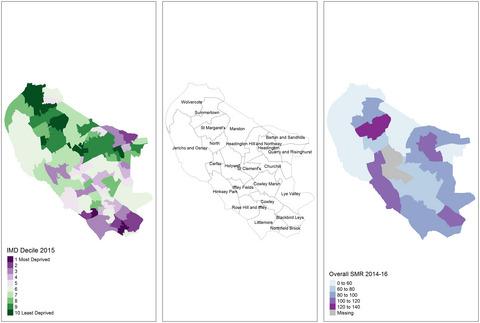Our official English website, www.x-mol.net, welcomes your
feedback! (Note: you will need to create a separate account there.)
Who still dies young in a rich city? Revisiting the case of Oxford
The Geographical Journal ( IF 3.6 ) Pub Date : 2020-01-14 , DOI: 10.1111/geoj.12336 Nicola Brimblecombe 1 , Danny Dorling 2 , Mark Green 3
The Geographical Journal ( IF 3.6 ) Pub Date : 2020-01-14 , DOI: 10.1111/geoj.12336 Nicola Brimblecombe 1 , Danny Dorling 2 , Mark Green 3
Affiliation

|
There are substantial inequalities in mortality and life expectancy in England, strongly linked to levels of deprivation. Mortality rates among those who are homeless are particularly high. Using the city of Oxford (UK) as a case study, we investigate ward-level premature standardised mortality ratios for several three-year and five-year periods between 2002 and 2016, and explore the extent to which the mortality of people who become homeless contributed to any rise or fall in geographical inequalities during this period. Age–sex standardised mortality ratios (SMRs) for people aged under 65 years old, with and without deaths among the homeless population, were calculated using Office for National Statistics Death Registration data for England and Wales 2002−2016. Individuals who were homeless or vulnerably housed were identified using records supplied by a local Oxford homeless charity. We found that in an increasingly wealthy, and healthy, city there were persistent ward-level inequalities in mortality, which the city-wide decrease in premature mortality over the period masked. Premature deaths among homeless people in Oxford became an increasingly important contributor to the overall geographical inequalities in health in this city. In the ward with the highest SMR, deaths among the homeless population accounted for 73% of all premature deaths of residents over the whole period; in 2014–2016 this proportion rose to 88%. Homelessness among men (the vast majority of the known homeless population) in this gentrifying English city rose to become the key explanation of geographical mortality patterns in deaths before age 65 across the entire city, particularly after 2011. Oxford reflects a broader pattern now found in many places across England of increasing homeless deaths, widening geographical inequalities in life expectancy, and sharp increases in all-age SMRs. The answer to the question, “Who dies young in a rich, and in fact an even richer, place?” is – increasingly – the homeless.
中文翻译:

谁还在富饶的城市英年早逝?重温牛津的案例
英格兰的死亡率和预期寿命存在很大的不平等,这与贫困程度密切相关。无家可归者的死亡率特别高。以牛津市(英国)为例,我们调查了 2002 年至 2016 年间几个三年和五年期间的病房级过早标准化死亡率,并探讨了无家可归者的死亡率造成这一时期地域不平等的任何上升或下降。使用英格兰和威尔士国家统计局 2002-2016 年的死亡登记数据计算 65 岁以下人群的年龄-性别标准化死亡率(SMR),包括无家可归者中有无死亡者。使用牛津当地无家可归者慈善机构提供的记录识别无家可归者或弱势群体。我们发现,在一个日益富裕和健康的城市中,病房级死亡率持续存在不平等,而在此期间全市范围内过早死亡率的下降掩盖了这一点。牛津无家可归者的过早死亡成为该城市整体健康地域不平等的一个越来越重要的因素。在 SMR 最高的病房中,无家可归者的死亡人数占整个期间居民过早死亡人数的 73%;2014-2016 年,这一比例上升到 88%。在这座高档的英国城市,男性(绝大多数已知的无家可归人口)的无家可归已成为整个城市 65 岁之前死亡的地理死亡率模式的关键解释,尤其是在 2011 年之后。牛津反映了现在发现的更广泛的模式英格兰许多地方的无家可归者死亡人数增加,预期寿命的地域不平等扩大,所有年龄的 SMR 急剧增加。问题的答案是:“谁在富人,甚至更富人的地方英年早逝?” 越来越多地成为无家可归者。问题的答案是:“谁在富人,甚至更富人的地方英年早逝?” 越来越多地成为无家可归者。问题的答案是:“谁在富人,甚至更富人的地方英年早逝?” 越来越多地成为无家可归者。
更新日期:2020-01-14
中文翻译:

谁还在富饶的城市英年早逝?重温牛津的案例
英格兰的死亡率和预期寿命存在很大的不平等,这与贫困程度密切相关。无家可归者的死亡率特别高。以牛津市(英国)为例,我们调查了 2002 年至 2016 年间几个三年和五年期间的病房级过早标准化死亡率,并探讨了无家可归者的死亡率造成这一时期地域不平等的任何上升或下降。使用英格兰和威尔士国家统计局 2002-2016 年的死亡登记数据计算 65 岁以下人群的年龄-性别标准化死亡率(SMR),包括无家可归者中有无死亡者。使用牛津当地无家可归者慈善机构提供的记录识别无家可归者或弱势群体。我们发现,在一个日益富裕和健康的城市中,病房级死亡率持续存在不平等,而在此期间全市范围内过早死亡率的下降掩盖了这一点。牛津无家可归者的过早死亡成为该城市整体健康地域不平等的一个越来越重要的因素。在 SMR 最高的病房中,无家可归者的死亡人数占整个期间居民过早死亡人数的 73%;2014-2016 年,这一比例上升到 88%。在这座高档的英国城市,男性(绝大多数已知的无家可归人口)的无家可归已成为整个城市 65 岁之前死亡的地理死亡率模式的关键解释,尤其是在 2011 年之后。牛津反映了现在发现的更广泛的模式英格兰许多地方的无家可归者死亡人数增加,预期寿命的地域不平等扩大,所有年龄的 SMR 急剧增加。问题的答案是:“谁在富人,甚至更富人的地方英年早逝?” 越来越多地成为无家可归者。问题的答案是:“谁在富人,甚至更富人的地方英年早逝?” 越来越多地成为无家可归者。问题的答案是:“谁在富人,甚至更富人的地方英年早逝?” 越来越多地成为无家可归者。











































 京公网安备 11010802027423号
京公网安备 11010802027423号